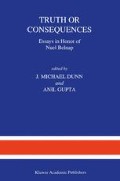Abstract
I owe much to my thesis director Nuel Belnap, but I wonder if I can blame him for my recent idealist tendencies. The novelist Colin Wilson (1967) has a theory of ideas as infectious agents, much like viruses and needing hosts. It is interesting to speculate how the idealist infection was transmitted from Blanshard to Anderson and Belnap at Yale, and from them to me as their graduate student at Pittsburgh. Perhaps rather than being an infectious disease it is a hereditary one, linked in some complicated way with the intellectual genes for relevance logic, Platonism, and logical humor.
I will not repeat here all of the acknowledgements made in Dunn (1987, 1990), but many of those same people continue to have an effect on the present paper. Also I want to thank my new colleague Anil Gupta for some very helpful conversations.
Access this chapter
Tax calculation will be finalised at checkout
Purchases are for personal use only
Preview
Unable to display preview. Download preview PDF.
Bibliography
Anderson, A. R. and Belnap, N. D. et al. (1975): Entailment: The Logic of Relevance and Necessity, vol. 1, Princeton Univ. Press.
Belnap, N. D. (1967): “Intensional Models for First Degree Formulas,” The Journal of Symbolic Logic, 32, pp. 1–22.
Blanshard, B. (1962): Reason and Analysis, La Salle, Illinois: Open Court Publishing Company.
Bosanquet, B. (1888): Logic, or the Morphology of Knowledge, 3 vols., Oxford Univ. Press, 2nd edition, 1911.
Dunn, J. M. (1987): “Relevant Predication 1: The Formal Theory,” Journal of Philosophical Logic, 16, pp. 347–381.
Dunn, J. M. (1990): “Relevant Predication 2: Intrinsic Properties and Internal Relations,” forthcoming in Philosophical Studies.
Ewing, A. C. (1934): Idealism, A Critical Survey, London: Methuen & Co., Ltd.
Forbes, G. (1985): The Metaphysics of Modality, Oxford: Clarendon Press.
Hintikka, J. (1962): Knowledge and Belief, Ithaca: Cornell University Press.
Hintikka, J. (1967): “Individuals, Possible Worlds, and Epistemic Logic,” Noûs, 1, pp. 33–62.
Kripke, S. A. (1963): “Semantical Considerations on Modal Logic,” Acta Philosophica Fennica, 16, pp. 83–94.
Kripke, S. A. (1972): Naming and Necessity, republished 1980 by Harvard University Press.
Lewis, D. K. (1968): “Counterpart Theory and Quantified Modal Logic,” The Journal of Philosophy, 65, pp. 113–126.
Maksimova, L. (1973): “A Semantics for the Calculus E of Entailment,” Bulletin of the Section of Logic, Polish Academy of Sciences, Institute of Philosophy and Sociology, 2, pp. 18–21.
Barcan Marcus, R. (1967): “Essentialism in Modal Logic,” Noûs, 1, pp. 91–96.
Meyer, R. K., Dunn, J. M. and Leblanc, H. (1974): “Completeness of Relevant Quantification Theories,” Notre Dame Journal of Formal Logic, 15, pp. 97–121.
Moore, G. E. (1922): “External and Internal Relations,” in Philosophical Studies, New York: Harcourt, Brace & Co. Inc., pp. 253–275.
Moore, G. E. (1962): Common-place Book 1919-1953, ed. C. Lewy, London: George Allen & Unw in Ltd.
Parsons, T. (1967): “Grades of Essentialism in Modal Logic,” Noûs, 1, pp. 156–174.
Quine, W. V. O. (1956): “Three Grades of Modal Involvement,” in The Ways of Paradox, New York: Random House.
Thomason, R. H. and Stalnaker, R. C. (1968): “Modality and Reference,” 2, pp. 359–372.
Thomason, R. H. and Stalnaker, R. C. (1968a): “Abstraction in First-Order Modal Logic,” Theoria, 34, pp. 203–207.
Wilson, C. (1967): The Mind Parasites, Oakland, California: Oneiric Press.
Editor information
Editors and Affiliations
Rights and permissions
Copyright information
© 1990 Kluwer Academic Publishers
About this chapter
Cite this chapter
Dunn, J.M. (1990). Relevant Predication 3: Essential Properties. In: Dunn, J.M., Gupta, A. (eds) Truth or Consequences. Springer, Dordrecht. https://doi.org/10.1007/978-94-009-0681-5_6
Download citation
DOI: https://doi.org/10.1007/978-94-009-0681-5_6
Publisher Name: Springer, Dordrecht
Print ISBN: 978-94-010-6791-1
Online ISBN: 978-94-009-0681-5
eBook Packages: Springer Book Archive

